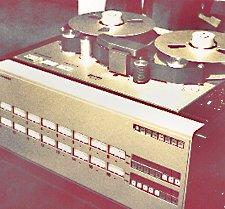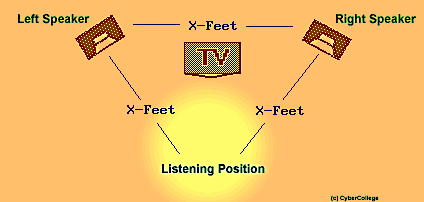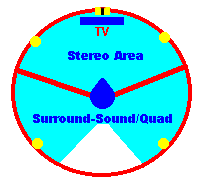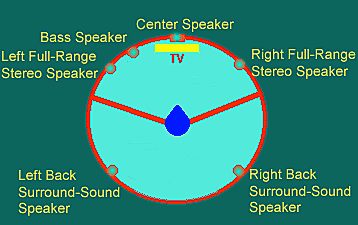|
Module 42 |
Updated: 07/07/2005 |
|
Stereo,
Just as we see in 3-D, we also, in a sense, hear in 3-D. Our ability to judge visual depth and perception is based on interpreting the subtle differences between the images we see in our left and right eyes. Our ability to locate the where sounds are originating is possible in part because we have learned to unconsciously understand the minute and complex time-difference relationship between the sounds from our left and right ears. If a sound comes from our left side, the sound waves will reach our left ear a fraction of a second before they reach our right ear. We've learned to interpret this subtle time difference, which is technically known as a phase difference. Depending upon the location of a sound, we might also note a slight difference in loudness between sounds that occur on our left and sounds coming from our right—which also helps us place the sound in a three-dimensional perspective. In stereo production we are dealing with sound intended for our left and right ears, and the inherent differences represented. Therefore, recording and playing back stereo signals requires two audio channels. |
|
In TV production there are several approaches to creating the stereo effect. First, there is synthesized stereo, where stereo is simulated electronically. Here, a monaural (one channel, non-stereo) sound is electronically processed to create a two-channel, stereo signal. A slight bit of reverb (reverberation, or echo) adds to the effect. Although this is not true stereo, when reproduced through stereo speakers, the sound will be perceived as having more dimension than monaural sound. True stereo is only possible if the original sound is recorded with two microphones, or a microphone with two sound-sensing elements. This process is fairly simple when the output of a stereo mic is recorded on two audio tracks and the two tracks are subsequently reproduced with two speakers. Things get much more complicated when you want to mix in narration, music, and special effects. Typically in productions a monophonic (non-stereo) recording of narration is mixed into a background of stereo music or on-location stereo sound. The narration (or dialogue in a dramatic production) is typically placed "center stage" and the stereo track adds a left-to-right stereo dimension. But, what if you are doing more sophisticated audio work, such as a contemporary music session, where you want to record the various instruments separately and then carefully and creatively mix them down to stereo tracks? In a TV production the placement of instruments, vocalists, etc., in a setting is commonly arranged on the basis of how things will look visually, and not optimum sound balance. For this reason you typically need to mic each element separately and then create the best sound balance by controlling each instrument or element with an audio board. For this you need — Multi-Track Recording Recorders are available
that will record from 8 to more than 40 Today, audio tape is being rapidly replaced by digital recording on hard disks. By recording the various sources of sound on separate audio tracks, they can later be placed in any left-to-right sound perspective. The unique and creative sound of many of today's recording artists originates in the "mix" created by recording engineers. Recordings of classical
music and orchestras are often done with only one (strategically placed) stereo
mic. In this case, the sound mix and balance are the responsibility of the conductor
rather than an audio engineer. Stereo Mics
Stereo mics are useful in on-location productions where things need to be kept simple and audio can be successfully miced from one location. This approach can be limited in stereo separation
(a clear and distinct separation between the left and right stereo channels), unless
the mics are somewhat directional and optimized for stereo. Although not as convenient,
two separate mics are often used in either an X-Y or M-S configuration. The X-Y and M-S Micing Techniques The X-Y
technique (illustrated directly below) is the simplest approach. Two cardioid
mics are pointed toward the subject matter, creating about a 130 arc across the
top. This technique is more often used in the United Kingdom than in the United
States. Although more technically complex, some engineers feel that the mid-side, or M-S technique (on the right) produces better results in a variety of situations. In this case, bi-directional and unidirectional (supercardioid) mics are used together. The directional mic (shown in dark blue in the illustration on the right above) picks up the basic audio in the center of the scene. The bi-directional mic's polar pattern (shown in green) is shaped somewhat like a figure-8. This means that the areas of minimum sensitivity are oriented toward the center of the scene and the camera (which would be at the bottom of this drawing). MS mics are available that include both of these mic elements within a single housing. The area of reduced sensitivity that is directed toward the camera (the very bottom of the green area in the M-S design) ends up being an advantage because behind-the-camera noise is reduced. The dead spot oriented toward the center of the scene (where most dialogue originates) is covered by the directional mic. The outputs of both mics are fed through a complex audio matrix
circuit that uses the phasing differences of the mics to produce the left and right
channels. Adjustments to this circuit allow considerable latitude in varying the
overall stereo effect. The Stereo Perspective in TV Audio Stereo audio in TV production faces a major problem because camera angles and distances shift with each new camera shot. Because of this, it's almost impossible—or at least it would be pretty confusing—if the stereo perspective shifted with each change in camera angle. For example, in an on-location sequence shot at the beach it would be rather disconcerting if the ocean's audio position jumped from left to right with each reverse-angle shot. So we have to compromise. In the case of an ocean, an audio engineer might place the ocean (or a sound effect of the ocean) in a left-to-right perspective that matches the initial wide-angle establishing shot and then hold that same stereo perspective in the audio tracks for subsequent closeups—even reverse-angle shots. Although the sound perspective might not be true to what you see on the screen, there won't be abrupt changes in audio that would be call attention to themselves and be distracting.
A pan pot consists of two or more faders (volume controls) ganged together. They can be used on an audio board during postproduction to slowly move a source of sound from one stereo channel to the other. This will avoid jarring shifts in sound perspective as shots are changed. Changes in the stereo placement ends up being a creative decision. There are no rules, but there are two guidelines. First, try to simulate the authentic stereo sound perspective
whenever possible. The second guideline, which is even more important, says it's
never desirable to use a production technique—in either audio or video—that diverts
viewer attention away from production content. It's better to hold back on authenticity
rather than use an effect that will call attention to itself. Keeping Dialogue "Center Stage" For maximum sound clarity the dialogue for dramatic productions should be mixed to keep it in the center of the stereo perspective. In most cases this will conform to what you see on the screen. The momentary exception might be when someone or something enters from one side of a scene. Even with center-stage dialogue, a stereo perspective can be added by mixing in stereo background music and sound effects during postproduction. In sporting events background stereo sound of the crowd is typically mixed in with monophonic feeds of play-by-play narration. If there are two announcers, pan pots can be used to place them slightly to the left and right of center (but never at the extreme ends of the left-right stereo perspective). For cuts to roving cameras focused on cheerleaders or sideline
activity a stereo mic mounted on the camera can be faded into into existing program
audio when that camera is switched up. Stereo Playbacks Although many TV sets have stereo speakers built in, the limited distance between the speakers in most TV sets limit the stereo separation, and, therefore, the stereo effect. (We'll discuss digital 5.1 surround-sound later in this module.) Ideally, a stereo signal should be reproduced by two good-quality
speakers placed about one meter (three feet) on either side of an average-sized
TV set. The distance between the speakers depends on the viewing distance and the size of the screen. The farther back the listener is, the greater the distance can be between the speakers. In the drawing above the "X" distance would be the same in each case. If a noticeable audio "hole" seems to be present between the left and right sound sources, the speakers are too far apart. When stereo speakers are built into the base of TV sets, we generally have the opposite problem—there is not enough room between the speakers.
When connecting wires to amplifiers and stereo speakers, pay particular attention to electrical polarity—the positive and negative leads (wires) to the speakers. Generally, one of the wires will be different—possibly it will be a different color or have a subtle stripe. Amplifiers will often have red and black terminal connections to indicate the plus or minus electrical differences. If you do not maintain this consistency (polarity) in hooking up both the amplifier and speaker connections, the audio will be out of phase, and, among other things, you will experience sound cancellation effects and a loss of bass. While we are talking about this, you need to know that it's
never a good idea to operate an amplifier without speakers being connected—especially
with the volume turned up. Without "the load" of the speakers, some amplifiers can
burn out. Stereo covers about a 120-degree frontal perspective. Although this provides significant realism, we can actually perceive sounds in a much wider perspective—even in back of us.
Even though the number of homes equipped with surround-sound decoders is still limited, many productions are now being done in surround-sound. In playing back true surround or quadraphonic sound at least five speakers are needed. The positions are indicated with small yellow areas in this drawing. Six speakers are needed to take full advantage of the 5.1, HDTV/digital TV capabilities (to be explained below). Although ideal, placing five or six speakers an equal distance from all listeners/viewers in a room full of furniture definitely challenges an interior decorating scheme. To tackle this problem psychoacoustic researchers analyzed the
way we hear sounds and came up with a surround-sound system that uses only two speakers.
To achieve the expanded effect, multi-channel audio recordings are digitized and
fed into a computer during postproduction. Using this technique, even a vertical
dimension can be suggested. While not as good as a five- or six-speaker setup,
it's an improvement over standard stereo. Quadraphonic Mics Quad mics, mics that detect sounds in nearly a 360-degree perspective have four mic elements within a single housing. Typically, an upper capsule contains two mic elements and picks up sound from the left-front and right-rear. Another capsule mounted below this one picks up sound from the right-front and left-rear. These are then recorded onto four audio tracks. During postproduction the four audio tracks are fed through a computer and mixed with tracks of music and effects (M&E) to develop a full surround-sound effect.
T he
Dolby 5.1 Surround Sound system used in HDTV consists of six discrete channels
of audio: left, center and right channels in front of listeners, and left-surround
and right-surround at the back sides. The 6th channel is a bass channel of limited frequency response (3-120Hz). Although it's capable of producing a room-rattling bass, it only takes up one-tenth of a full-range audio channel. Hence, the system is referred to as 5.1. Bass is nondirectional, so the speaker can be placed almost anywhere in the room. By using signal compression, all of the audio channels can be transmitted in a comparatively limited space (bandwidth). Even so, accommodating the full capabilities of this type of audio in TV production requires audio boards with a six-channel capacity. This brings us squarely into the next topic: digital audio. |

 separate
audio tracks on a single piece of one-inch or two-inch audiotape. The recorder shown
on the right records 16-tracks on two-inch, reel-to-reel tape. Even more audio tracks
can be recorded by synchronizing two or more multi-track recorders together with
SMPTE time code (to be discussed later).
separate
audio tracks on a single piece of one-inch or two-inch audiotape. The recorder shown
on the right records 16-tracks on two-inch, reel-to-reel tape. Even more audio tracks
can be recorded by synchronizing two or more multi-track recorders together with
SMPTE time code (to be discussed later). The
easiest approach to stereo recording is to use an all-in-one stereo
mic, which is basically two mics mounted in a single housing, or, as shown
on the left, two mics mounted outside of a housing.
The
easiest approach to stereo recording is to use an all-in-one stereo
mic, which is basically two mics mounted in a single housing, or, as shown
on the left, two mics mounted outside of a housing.
 However, for lengthy shots that clearly represent
changes in stereo perspective, a pan pot can be used to subtly shift the
ocean so that a true left-to-right stereo perspective is simulated.
However, for lengthy shots that clearly represent
changes in stereo perspective, a pan pot can be used to subtly shift the
ocean so that a true left-to-right stereo perspective is simulated. 
 Surround-sound and quadraphonic sound
systems attempt to reproduce sounds in both the front and back of the listener—close
to a 360-degree sound perspective.
Surround-sound and quadraphonic sound
systems attempt to reproduce sounds in both the front and back of the listener—close
to a 360-degree sound perspective. If you've been counting, that only totals five channels, not six.
If you've been counting, that only totals five channels, not six.